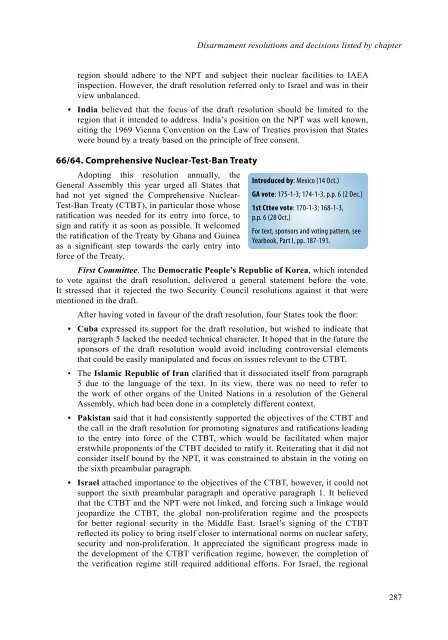DYB2011-Part-II-web
DYB2011-Part-II-web
DYB2011-Part-II-web
You also want an ePaper? Increase the reach of your titles
YUMPU automatically turns print PDFs into web optimized ePapers that Google loves.
Disarmament resolutions and decisions listed by chapter<br />
region should adhere to the NPT and subject their nuclear facilities to IAEA<br />
inspection. However, the draft resolution referred only to Israel and was in their<br />
view unbalanced.<br />
• India believed that the focus of the draft resolution should be limited to the<br />
region that it intended to address. India’s position on the NPT was well known,<br />
citing the 1969 Vienna Convention on the Law of Treaties provision that States<br />
were bound by a treaty based on the principle of free consent.<br />
66/64. Comprehensive Nuclear-Test-Ban Treaty<br />
Adopting this resolution annually, the<br />
General Assembly this year urged all States that<br />
had not yet signed the Comprehensive Nuclear-<br />
Test-Ban Treaty (CTBT), in particular those whose<br />
ratification was needed for its entry into force, to<br />
sign and ratify it as soon as possible. It welcomed<br />
the ratification of the Treaty by Ghana and Guinea<br />
as a significant step towards the early entry into<br />
force of the Treaty.<br />
Introduced by: Mexico (14 Oct.)<br />
GA vote: 175-1-3; 174-1-3, p.p. 6 (2 Dec.)<br />
1st Cttee vote: 170-1-3; 168-1-3,<br />
p.p. 6 (28 Oct.)<br />
For text, sponsors and voting pattern, see<br />
Yearbook, <strong>Part</strong> I, pp. 187-191.<br />
First Committee. The Democratic People’s Republic of Korea, which intended<br />
to vote against the draft resolution, delivered a general statement before the vote.<br />
It stressed that it rejected the two Security Council resolutions against it that were<br />
mentioned in the draft.<br />
After having voted in favour of the draft resolution, four States took the floor:<br />
• Cuba expressed its support for the draft resolution, but wished to indicate that<br />
paragraph 5 lacked the needed technical character. It hoped that in the future the<br />
sponsors of the draft resolution would avoid including controversial elements<br />
that could be easily manipulated and focus on issues relevant to the CTBT.<br />
• The Islamic Republic of Iran clarified that it dissociated itself from paragraph<br />
5 due to the language of the text. In its view, there was no need to refer to<br />
the work of other organs of the United Nations in a resolution of the General<br />
Assembly, which had been done in a completely different context.<br />
• Pakistan said that it had consistently supported the objectives of the CTBT and<br />
the call in the draft resolution for promoting signatures and ratifications leading<br />
to the entry into force of the CTBT, which would be facilitated when major<br />
erstwhile proponents of the CTBT decided to ratify it. Reiterating that it did not<br />
consider itself bound by the NPT, it was constrained to abstain in the voting on<br />
the sixth preambular paragraph.<br />
• Israel attached importance to the objectives of the CTBT, however, it could not<br />
support the sixth preambular paragraph and operative paragraph 1. It believed<br />
that the CTBT and the NPT were not linked, and forcing such a linkage would<br />
jeopardize the CTBT, the global non-proliferation regime and the prospects<br />
for better regional security in the Middle East. Israel’s signing of the CTBT<br />
reflected its policy to bring itself closer to international norms on nuclear safety,<br />
security and non-proliferation. It appreciated the significant progress made in<br />
the development of the CTBT verification regime, however, the completion of<br />
the verification regime still required additional efforts. For Israel, the regional<br />
287


